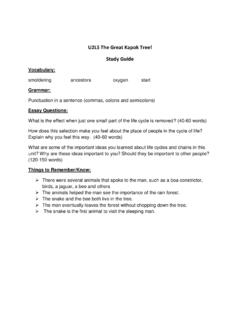Transcription of Unit 3 Brazil Lesson 9 The Great Kapok Tree - PNW …
1 Grade 3: Communities Around the World Unit 3 Brazil Lesson 9 The Great Kapok tree Putnam/Northern Westchester BOCES Grade 3 Integrated Social Studies/English Language Arts Curriculum Page 1 Revised June 2012 Overview: Students will be introduced to the Amazon Rain Forest through a fictional read aloud, and will respond to it in writing that mirrors the ELA assessment. Then they will consider the plight of the rain forest today thorough a combination of photographs, video, a virtual field trip, and non-fictional articles. Suggested time allowance: 3 class period(s) Standards: : The study of world history requires an understanding of world cultures and civilizations, including an analysis of important ideas, social and cultural values, beliefs, and traditions. : Recount stories, including fables, folktales, and myths from diverse cultures; determine the central message, Lesson , or moral and explain how it is conveyed through key details in the text.
2 : Determine the main idea of a text; recount the key details and explain how they support the main idea. : Write opinion pieces on topics or texts, supporting a point of view with reasons. Essential Unit Questions: How has geography affected the development of Brazil ? Why should we be concerned with preserving the Amazon Rain Forest? Resources/Materials for this Lesson : (Recommended book is bold) Cherry, Lynne. The Great Kapok tree : A Tale of the Amazon Rain Forest San Diego, CA: Harcourt Brace Jovanovich, 1990. Exhausted from his labors, a man chopping down a Great Kapok tree in the Brazilian rain forest puts down his ax, and, as he sleeps, the animals who live in the tree plead with him not to destroy their world. This modern fable with its urgent message contains an abundance of information in the text and in the lush paintings that portray the wildlife and vegetation of the area.
3 "Amazon Rainforest" video. June 2012. The tropical rainforests of Brazil are home to thousands of species of plants and animals. This short video segment from the Race to Save the Planet explores both the ecological importance and fragility of the rainforest biome and its organisms. Grade 3: Communities Around the World Unit 3 Brazil Lesson 9 The Great Kapok tree Putnam/Northern Westchester BOCES Grade 3 Integrated Social Studies/English Language Arts Curriculum Page 2 Revised June 2012 Photos of Deforestation in the Rainforest. Rhett A. Butler. June 14, 2007 A selection of photographs. The Rain Forest s Ecosystem. Montana State University Education Department June 14, 2007 A webquest during which students to research about the animals of the rain forest, keep a journal, and then share their finding with their classmates.
4 Tropical Rainforests. Camden Children s Garden. A Virtual Field Trip. There is a cost associated with this program. Tropical Rainforests: Saving What Remains. Chapter 10: SOLUTIONS: How to Save Tropical Rainforests.. Rhett A. Butler. June 14, 2007. Background for teachers. How Can We Save Rainforests? Rhett A. Butler. June 14, 2007. This site contains readings for students and a wonderful page called What You Can Do At Home to Help the Environment. The reading level may be challenging for some students. Top 5 Forest Destroyers and Top 5 Forest Replanters. June 14, 2007. ,27972,48693, A list with explanation. Great Kapok tree Extended Response (included) Great Kapok tree Rubric (included) Activities/Procedures: Day 1 Read aloud The Great Kapok tree : A Tale of the Amazon Rain Forest by Lynne Cherry.
5 Students will take notes while listening. Day 2 Distribute the Great Kapok tree packet. Review the directions and the rubric. Allow 45 minutes for students to complete written responses. This time frame can mirror ELA test situation. Day 3 1. After brainstorming what students know about the rainforests, the teacher should pose the question, why should we be concerned with preserving the Amazon Rain Forest? Grade 3: Communities Around the World Unit 3 Brazil Lesson 9 The Great Kapok tree Putnam/Northern Westchester BOCES Grade 3 Integrated Social Studies/English Language Arts Curriculum Page 3 Revised June 2012 2. Select appropriate resources from the list above, and direct students to discover the answer to why should we be concerned with preserving the Amazon Rain Forest and what we can do about the problem.
6 3. Have students share their answers with the class. Evaluation/Assessment: Teacher will use the attached rubric to assess The Great Kapok tree SS/ELA written responses. Vocabulary: deforestation preservation










